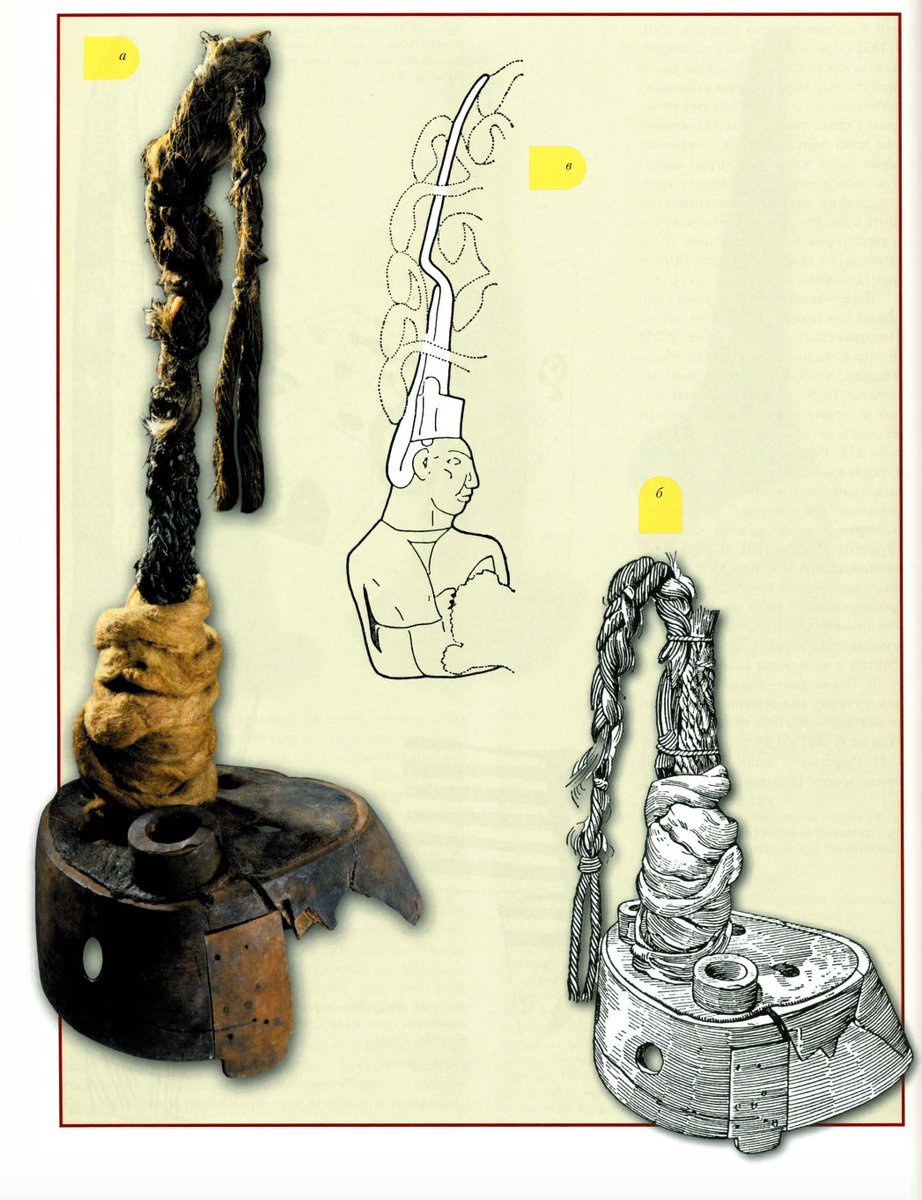
Some lesser known Pazyryk Scythian finds
1) Some of the clothing: this style with a tail is fairly unique to Pazyryk culture & this era. But also something you will likely see in the next decade at a fashion show...
⤵️🧵

1) Some of the clothing: this style with a tail is fairly unique to Pazyryk culture & this era. But also something you will likely see in the next decade at a fashion show...
⤵️🧵


Belts
Belt buckles and decorations, whether among Parthians or other Iranian groups, were similarly placed on the belts
⤵️



Belt buckles and decorations, whether among Parthians or other Iranian groups, were similarly placed on the belts
⤵️




2) Pointed caps, headwear & hair
The Massagetae, likely the same as the Sakā tigraxaudā (Old Persian: 𐎿𐎣𐎠 𐏐 𐎫𐎡𐎥𐎼𐎧𐎢𐎭𐎠 Sakā tigraxaudā, "wearer of pointed caps") were an ancient Eastern Iranian Saka people who inhabited the steppes of Central Asia
⤵️



The Massagetae, likely the same as the Sakā tigraxaudā (Old Persian: 𐎿𐎣𐎠 𐏐 𐎫𐎡𐎥𐎼𐎧𐎢𐎭𐎠 Sakā tigraxaudā, "wearer of pointed caps") were an ancient Eastern Iranian Saka people who inhabited the steppes of Central Asia
⤵️




Not every Scythian tribe & group had these massive caps & hair decorations
But the Pazyryk group seems to have had long hair decorations, at least for women
⤵️



But the Pazyryk group seems to have had long hair decorations, at least for women
⤵️




We can also see the long caps & headwear among some other Scythian groups,
4: Issyk kurgan, Kazakhstan
⤵️



4: Issyk kurgan, Kazakhstan
⤵️




We can for example compare the long headwear from Issyk kurgan, ~ 4th or 3rd century BCE
to photo 4: reconstruction from Arzhan, site of early #Scythian kurgan burials in the Tuva Republic, Russia: ~ 8th–7th C BCE
⤵️

to photo 4: reconstruction from Arzhan, site of early #Scythian kurgan burials in the Tuva Republic, Russia: ~ 8th–7th C BCE
⤵️


To some other examples of headwear among Scythian groups
3-4: Bosporan
Some of these are shorter caps that many Iranian groups wore, and which included extra fabric that at least the Achaemenids used to cover their face & mouth
⤵️



3-4: Bosporan
Some of these are shorter caps that many Iranian groups wore, and which included extra fabric that at least the Achaemenids used to cover their face & mouth
⤵️




Behistun, Darius Inscription & Relief
Possible depiction of Skunkha, king of the Sakā tigraxaudā ("Saka who wear pointed caps")
⤵️

Possible depiction of Skunkha, king of the Sakā tigraxaudā ("Saka who wear pointed caps")
⤵️


The Sarmatians generally didn't wear pointed caps from surviving depictions.
The Achaemenids also did not generally wear pointed caps, though there are a couple of examples of longer caps & hats from Central Asia
⤵️

The Achaemenids also did not generally wear pointed caps, though there are a couple of examples of longer caps & hats from Central Asia
⤵️


From Seleucid & Parthian eras, there are some depictions of more pointed caps (nowhere as long as Pazyryk & other Scythian examples), though their origin is likely different
4: Priest from Hatra
⤵️



4: Priest from Hatra
⤵️




Also see these Parthian-era examples, all from Syrian cities
We see women wearing a headwear called tantour, though with similarities to other groups in the region
2-4: Edessa
⤵️



We see women wearing a headwear called tantour, though with similarities to other groups in the region
2-4: Edessa
⤵️




Even among the Kushan, another group in Central Asia who had connections with & influences on various Iranian groups, we see depictions of pointed caps at times
⤵️



⤵️




The Sasanians also didn't generally wear pointed caps, though in some depictions we see longer caps (Kolah), with various shapes
1: @ Miho Museum
⤵️



1: @ Miho Museum
⤵️




More Sasanian examples of bigger headwear
1: al Sabah Collection
2: Hajiabad
3: Wyvern Collection, helmet or cap
⤵️



1: al Sabah Collection
2: Hajiabad
3: Wyvern Collection, helmet or cap
⤵️




Finally, in some depictions we do see Sogdians or other groups depicted by Sogdian artists with pointed caps (1-2: not the best examples here)
3-4: Alanic Sarmatian Iranians: generally did not wear pointed caps (many other pieces of headwear survive from ~ 7-10 C CE)



3-4: Alanic Sarmatian Iranians: generally did not wear pointed caps (many other pieces of headwear survive from ~ 7-10 C CE)




• • •
Missing some Tweet in this thread? You can try to
force a refresh












































